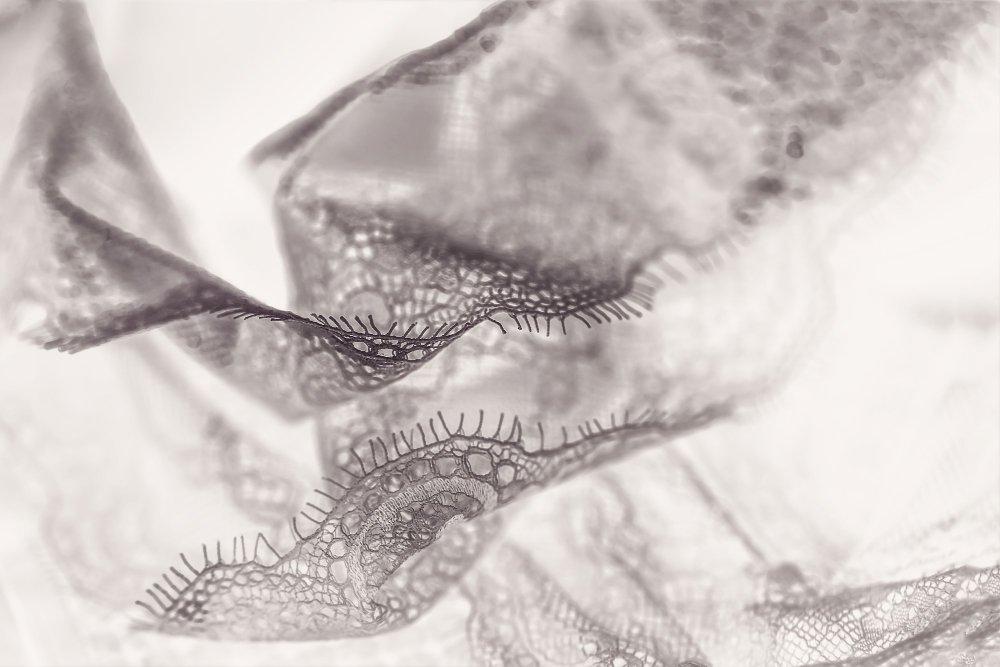From French Royal Courts to Modern Wedding Dresses: Everything You Need to Know
Have you ever wondered why some wedding dresses cost thousands while others are much more affordable? The answer often lies in one special detail: Alençon lace. This amazing fabric can transform an ordinary dress into something truly magical.
Alençon lace (pronounced “ah-len-SOHN”) is often called the “Queen of Lace” for good reason. It comes from the French town of Alençon in Normandy, where skilled craftspeople have been making it by hand for over 350 years. Today, you’ll find both handmade and machine-made versions, with prices ranging from $29 for simple trims to over $325 for elaborate beaded designs.
What Makes Alençon Lace Special?
The Meaning Behind Alençon
The name “Alençon” comes from the French town where this lace was born. When you see “Point d’Alençon” on a fabric label, it means “Alençon needlepoint” – the traditional way this lace was originally made with just a needle and thread.
Key Features That Set It Apart
Alençon lace has several features that make it easy to spot:
- Twisted cord outlines that create a 3D effect around each flower and leaf
- Raised patterns that you can actually feel with your fingers
- Delicate mesh background that lets light shine through beautifully
- Scalloped edges that often have tiny “eyelash” fringes
Think of it like embroidery that floats in the air. While regular lace fabric lies flat, Alençon lace has dimension and depth that catches light from every angle.
What Is Alençon Lace Used For?
You’ll most commonly see Alençon lace in:
- Wedding dresses – It’s the top choice for bridal gowns
- Evening wear – Perfect for formal occasions
- Curtains and home decor – Adds elegance to any room
- Jewelry – Vintage pieces dipped in gold or silver
- Veils and accessories – Completes the bridal look
- Heirloom pieces – Often passed down through families
Alençon vs. Chantilly Lace: What’s the Difference?
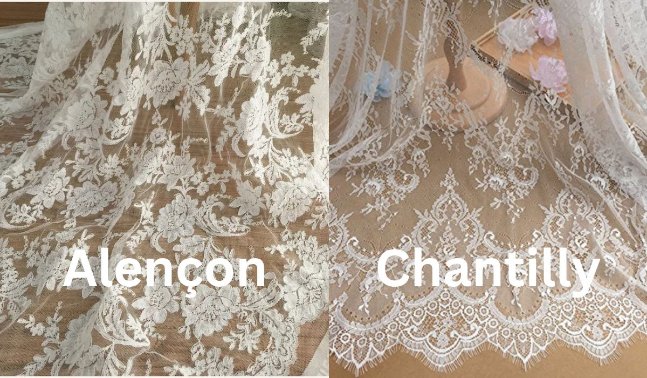
Many people get confused between these two French laces. Here’s a simple breakdown:
| Feature | Alençon Lace | Chantilly Lace |
|---|---|---|
| Construction | Has raised cord outlines | Flat, no raised edges |
| Thickness | Heavier and more structured | Lighter and softer |
| Base | Often built on Chantilly as foundation | Is the foundation fabric |
| Cost | More expensive due to extra work | Less expensive |
| Best For | Statement pieces, bodices | Overlays, sleeves, veils |
Think of it this way: Chantilly lace is like a beautiful drawing, while Alençon lace is like a sculpture. Both are gorgeous, but Alençon has that extra dimension.
The Rich History of Alençon Lace
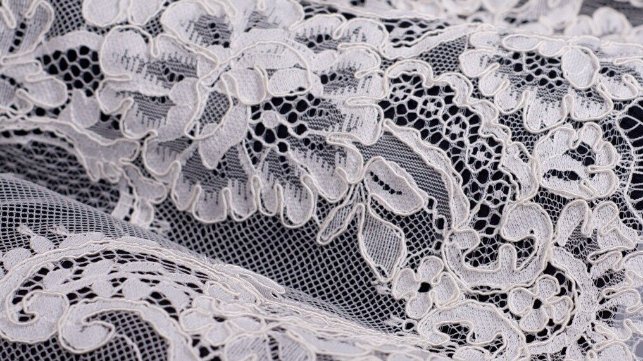
Royal Beginnings
Back in 1665, King Louis XIV had a problem. French nobles were spending huge amounts of money on Italian laces, and all that money was leaving France. So he started royal workshops in Alençon to make French lace that could compete with the best in the world.
The plan worked perfectly. According to historical documentation, by 1675, French Alençon lace had not only matched but surpassed Venetian imports in both quality and international demand. The technique developed by Marthe La Perrière had successfully modified the original Venetian methods, creating a distinctly French style that became the new gold standard for luxury lace.
UNESCO Recognition
In 2010, UNESCO recognized authentic Alençon lace-making as an Intangible Cultural Heritage of Humanity. This prestigious designation acknowledges that the traditional craftsmanship requires approximately seven hours per square centimeter and represents one of the world’s most refined needlework techniques.
Traditional Craftsmanship
Creating authentic Alençon lace by hand takes incredible skill. Here’s what’s involved:
- Design and transfer – Artists draw patterns on special parchment
- Outlining – Craftspeople lay foundation threads following the pattern
- Filling – Each section gets filled with intricate stitches
- Shading – Special techniques add depth and shadow
- Relief work – Raised edges get their final shape
- Finishing – Everything gets polished with a lobster claw tool
A single square centimeter can take up to seven hours to complete. No wonder authentic pieces cost so much!
How to Identify Authentic Alençon Lace
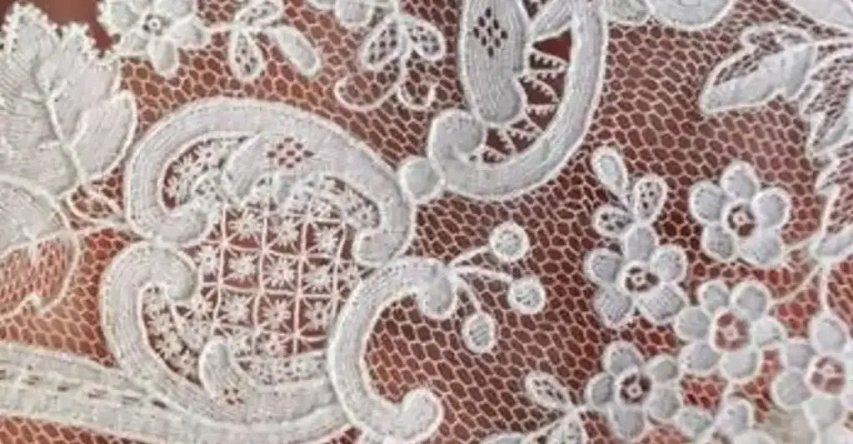
Wondering if you’re looking at real Alençon lace? Here are the telltale signs:
Visual Clues
- Raised cord outlines around every motif
- Consistent stitch density throughout
- Fine mesh background that’s barely visible
- Natural variations in handmade pieces
- Precise pattern alignment where pieces join
Touch Test
- Slightly stiff feeling from the cord work
- Smooth raised edges that don’t snag
- Quality thread that doesn’t feel scratchy
Price Reality Check
- Authentic handmade: $200-500+ per yard
- Quality machine-made: $50-150 per yard
- Basic versions: $10-50 per yard
If the price seems too good to be true for “authentic” Alençon lace, it probably is.
Working with Alençon Lace: Sewing Tips and Techniques
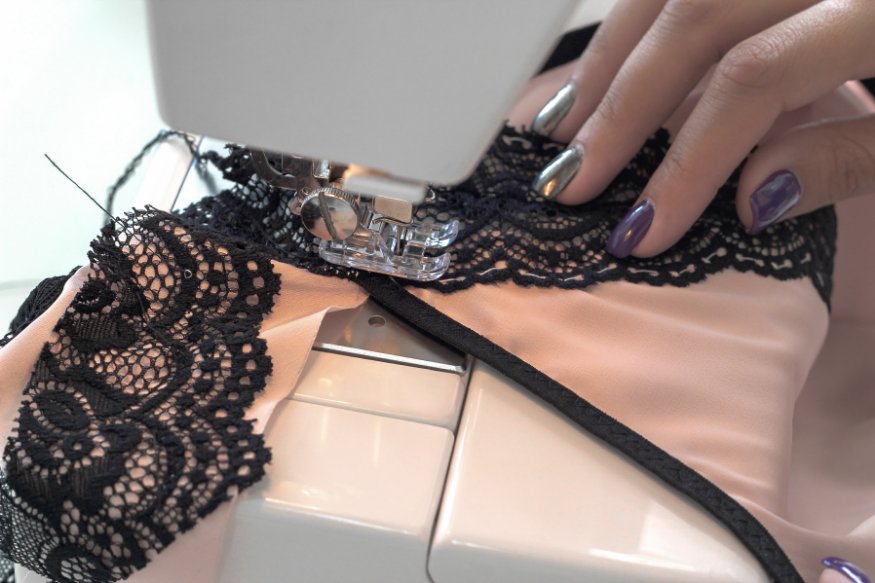
Choosing the Right Materials
When shopping for Alençon lace, consider these factors:
Width Options:
- 5-8 inch trims for sleeve accents
- 36-inch authentic French lace
- 46-60 inch machine-made versions for full skirts
Composition Types:
- Cotton/Rayon/Nylon blend: Best durability and drape
- All polyester: More affordable, easier care
- Cotton/Rayon: Softer feel, requires gentle handling
Color Choices: Traditional ivory and white remain popular, but modern options include:
- Navy blue and black for dramatic contrast
- Blush pink and peach for romantic looks
- Chocolate brown and slate gray for unique styles
Essential Sewing Techniques
The Appliqué Method
This is the best way to attach Alençon lace without visible seams:
- Cut individual motifs from the lace (lace doesn’t fray)
- Use tiny dots of fabric glue to position pieces
- Let glue dry completely (40-60 minutes)
- Zigzag stitch around edges using matching thread
- Use stitch width 3, length 3-4 for best results
Machine Settings for Success
- Needle: Size 11 or 14 universal
- Thread: Cotton or polyester to match lace color
- Tension: Slightly looser than normal to prevent puckering
- Presser foot: Walking foot for even feeding
Hand Sewing Approach
For the finest finish, especially on wedding dresses:
- Use weight 40 thread for strength
- Make tiny tacking stitches every 1/4 inch
- Work from the center outward
- Hide knots under the cord edges
Troubleshooting Common Problems
Problem: Lace puckers when sewn
Solution: Reduce thread tension and use a walking foot
Problem: Stitches show too much
Solution: Use thread that matches the lace exactly, or try clear monofilament thread
Problem: Cord edges fray during cutting
Solution: Use micro-serrated scissors and cut slowly
Advanced Applications and Project Ideas
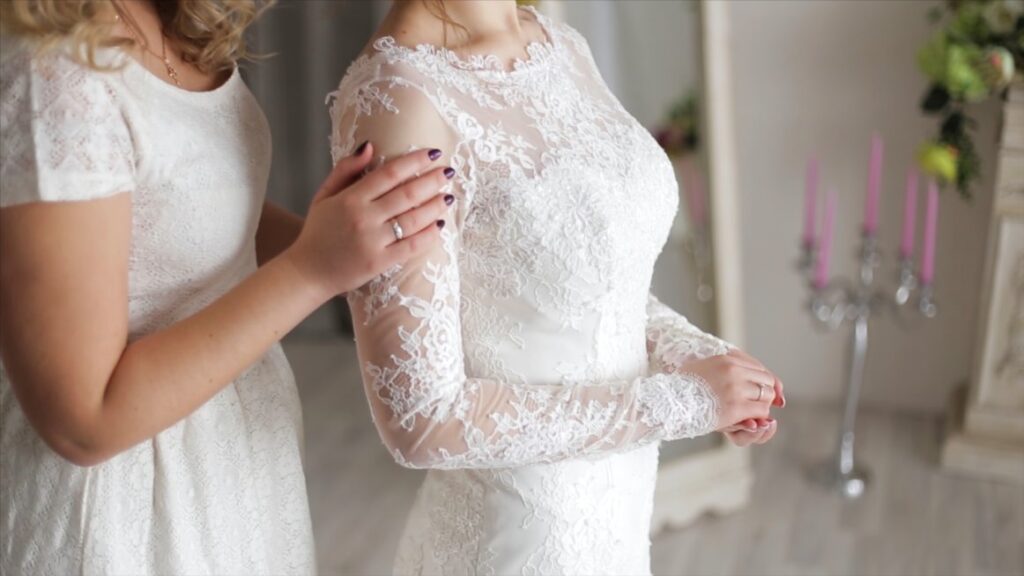
Wedding Dress Construction
When working with Alençon lace on wedding dresses:
- Plan your layout before cutting anything
- Match patterns across seam lines
- Add 15% extra fabric for pattern matching
- Layer over quality lining for best effect
Popular placement areas:
- Bodice appliqués for focal points
- Hem borders for drama
- Sleeve details for elegance
- Back panels for surprise elements
Beading Alençon Lace
Adding beaded details can make your project even more special:
Materials needed:
- Seed beads, pearls, or crystals
- Beading thread in matching color
- Fine beading needles
- Good lighting and magnification
Technique:
- Work on one flower motif at a time
- Knot after every 8-10 beads for security
- Follow the existing pattern lines
- Use about 10,000 beads for a full dress bodice
Creating Lace Jewelry
Transform leftover pieces into wearable art:
- Cut interesting motifs from scraps
- Clean thoroughly
- Have pieces dipped in 24k gold, silver, or rose gold
- Attach to jewelry findings
This makes meaningful gifts, especially for 13th wedding anniversaries when lace is the traditional gift.
Comparison Chart: Types of French Lace
| Lace Type | Construction | Weight | Best Use | Price Range |
|---|---|---|---|---|
| Alençon | Corded outlines | Medium-Heavy | Wedding dresses, formal wear | $50-300/yard |
| Chantilly | Flat embroidery | Light | Overlays, veils | $20-150/yard |
| Guipure | No mesh background | Heavy | Statement pieces | $30-200/yard |
| Venise | Needlepoint style | Medium | Trim, accents | $25-175/yard |
Caring for Your Alençon Lace

Cleaning Guidelines
For finished garments:
- Professional dry cleaning recommended
- Specify “delicate lace” to your cleaner
- Never use standard home dry cleaning kits
For fabric pieces:
- Hand wash in cool water if needed
- Use mild detergent designed for delicates
- Never wring or twist
- Lay flat to dry away from direct sunlight
Storage Tips
Short-term:
- Hang finished garments with padded hangers
- Cover with breathable cotton fabric bags
- Avoid plastic covers that trap moisture
Long-term preservation:
- Clean before storing
- Wrap in acid-free tissue paper
- Store flat in archival boxes
- Check annually for any issues
Repair and Restoration
Small tears can often be repaired:
- Secure loose threads immediately
- Use matching thread to reinforce weak areas
- Consider professional restoration for valuable pieces
- Document any changes for historical record
Shopping Guide: Where to Find Quality Alençon Lace
Online Sources
- Fabric specialty stores: Best selection and quality
- Bridal suppliers: Higher-end options
- Etsy: Vintage and handmade pieces
- Wholesale suppliers: Best prices for large quantities
What to Look For
- Clear, high-resolution photos
- Detailed descriptions including width and composition
- Return policies for online purchases
- Reviews from other customers
Budget Planning
- Budget projects: $10-30 per yard
- Mid-range quality: $30-100 per yard
- Premium pieces: $100-300+ per yard
- Authentic handmade: $300-500+ per yard
Remember to factor in the amount needed. A wedding dress typically requires 3-5 yards depending on the design.
Modern Innovations and Trends

New Color Palettes
While ivory and white remain classics, contemporary designers are exploring:
- Metallic threads woven into traditional patterns
- Ombré effects from light to dark
- Bold colors like emerald green and deep purple
- Two-tone combinations for unique contrast
Sustainable Options
As fashion becomes more environmentally conscious:
- Vintage lace is being repurposed into new designs
- Eco-friendly dyes are replacing harsh chemicals
- Local artisans are reviving traditional techniques
- Rental options make luxury lace more accessible
Technology Integration
Modern lace-making includes:
- Computer-aided design for precise patterns
- Advanced machinery that mimics hand techniques
- Quality control systems ensuring consistency
- Digital archiving of historical patterns
Frequently Asked Questions
How do you pronounce Alençon?
The correct pronunciation is “ah-len-SOHN” with a soft nasal ending. The “ç” makes an “s” sound, and the final “n” is barely pronounced.
Can I wash Alençon lace in a washing machine?
While some modern machine-made versions can handle gentle machine washing, it’s always safer to hand wash or professionally clean. The raised cord work can get damaged in regular wash cycles.
How much lace do I need for a wedding dress?
This depends on your design, but here are general guidelines:
• Bodice appliqués only: 1-2 yards
• Full overlay skirt: 3-4 yards
• Entire dress in lace: 4-6 yards
• Plus sleeves and details: Add 1-2 extra yards
What’s the difference between French and machine-made Alençon lace?
French authentic lace is made entirely by hand using traditional techniques, takes months to complete, and costs much more. Machine-made versions recreate the look using embroidery machines and are much more affordable.
Can I dye Alençon lace?
While possible, it’s risky and not recommended for valuable pieces. The different fibers in the blend may take dye differently, and the process can damage delicate cord work. If you need a specific color, it’s better to buy it already dyed.
How do I know if my lace is worth restoring?
Consider these factors:
• Age and historical significance
• Condition of the base mesh
• Integrity of the cord work
• Sentimental value
• Cost of restoration vs. replacement
Professional appraisal may be worthwhile for very old or potentially valuable pieces.
What needle should I use for sewing Alençon lace?
Use a size 11 (75/11) or 14 (90/14) universal needle. The larger size works better for heavier lace with thick cord work, while the smaller size is perfect for delicate pieces.
Can Alençon lace be steamed or ironed?
Never iron directly on the raised cord work. Use low steam with a velvet-covered pressing board, or hover the iron above the fabric. For best results, use a pressing cloth and work from the wrong side.
Conclusion
Alençon lace truly deserves its title as the “Queen of Lace.” From its royal beginnings in 17th-century France to today’s modern applications, this remarkable fabric continues to create breathtaking garments and treasured heirlooms.
Whether you’re planning a wedding dress, restoring a vintage piece, or simply exploring different fabric types, understanding Alençon lace opens up a world of creative possibilities. The key takeaways for working with this beautiful material are:
For Beginners: Start with smaller projects to learn the techniques. The appliqué method is forgiving and produces professional results. Don’t be afraid to practice on scraps first.
For Intermediate Sewers: Focus on proper fabric selection and invest in quality materials. The difference between cheap and good lace is dramatic and worth the extra cost.
For Advanced Projects: Plan extensively before cutting, especially for wedding dresses. Pattern matching and proper layout can make or break your final result.
For Everyone: Remember that this is a living tradition. Each piece you create with Alençon lace connects you to centuries of skilled craftspeople. Whether you choose affordable machine-made versions or invest in authentic handmade pieces, you’re participating in one of fashion’s most enduring art forms.
The beauty of Alençon lace lies not just in its appearance, but in its ability to transform ordinary moments into extraordinary memories. A wedding dress adorned with this “Queen of Lace” becomes an heirloom. A simple evening gown gains timeless elegance. Even small accents can elevate everyday garments into something special.
As you begin your own Alençon lace journey, remember that patience and practice lead to stunning results. Take time to appreciate the craftsmanship, whether in your own work or in the pieces you admire. In a world of fast fashion, Alençon lace reminds us that some things are worth doing slowly and doing well.
Your next project with this magnificent fabric awaits. Whether it’s a dream wedding dress, a special occasion gown, or a creative home décor piece, Alençon lace will help you create something truly unforgettable.


